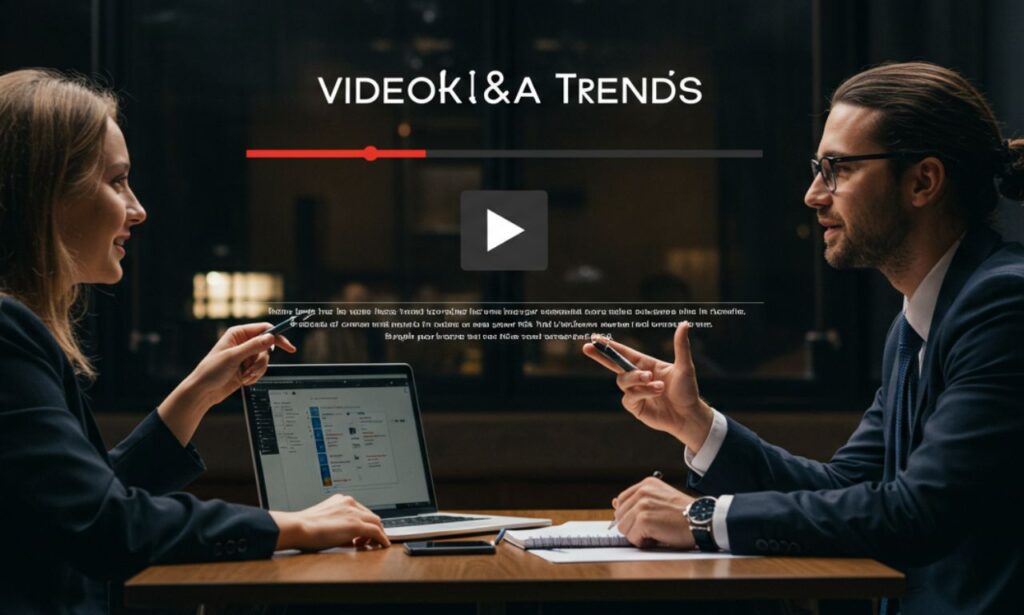Video&A has emerged as one of the most innovative and interactive forms of digital engagement. In 2025, this format is redefining how audiences consume information and connect with brands. Whether for education, marketing, or entertainment, Video&A blends video content with interactive Q&A elements, making experiences more dynamic and engaging.
In this article, we’ll explore what &A is, its benefits, tools for creating it, and how it is shaping the future of communication.
Video&A Overview
Video&A is an interactive format that combines pre-recorded or live video with real-time question-and-answer capabilities. Unlike traditional videos, where the audience passively watches, this format invites participation. Users can submit questions, vote on topics, and interact with presenters.
Businesses, educators, and creators are increasingly using &A to foster stronger audience engagement. The approach bridges the gap between content creators and viewers, encouraging meaningful interaction.
Video&A Industry Growth in 2025
The global adoption of Video&A has surged in the past two years. With remote work and online learning becoming mainstream, the demand for interactive video platforms has skyrocketed. Market reports show that &A adoption is growing at double-digit rates annually, driven by:
-
E-learning expansion: Schools and universities are using &A for virtual lectures and interactive assessments.
-
Corporate training: Businesses leverage &A for onboarding sessions, product demos, and team collaboration.
-
Marketing strategies: Brands host&A sessions for product launches, live feedback, and audience polls.
This growth reflects a shift from passive content consumption to two-way engagement, where participation drives value.
Video&A Benefits for Businesses
Businesses are finding Video&A to be an effective tool for several reasons:
-
Enhanced engagement: Live Q&A keeps audiences attentive and invested.
-
Actionable feedback: Immediate responses from participants help businesses improve products and services.
-
Stronger relationships:&A creates a sense of authenticity and trust.
-
Cost efficiency: Virtual events cut travel and venue costs while reaching larger audiences.
By combining video with interactive elements, brands gain better insights into consumer behavior.
Video&A Tools and Platforms
Several platforms specialize in Video&A experiences. These tools enable creators to add Q&A widgets, polls, chat functions, and analytics dashboards to video content. Popular categories of tools include:
-
Live streaming suites: Platforms like Vimeo Live, StreamYard, and Restream support integrated Q&A during live broadcasts.
-
Interactive video tools: Services like Slido, Mentimeter, and Hopin allow embedding Q&A into recorded sessions.
-
AI-powered moderation: Some tools now use AI to filter questions and prioritize relevant topics in real time.
Choosing the right tool depends on audience size, budget, and whether the content is live or pre-recorded.
Video&A in Education
Educational institutions have embraced &A for its ability to increase student participation. Online lectures now feature real-time question panels, where students can ask clarifying questions during class. Teachers can see which topics are confusing and address them immediately.
Moreover, &A allows asynchronous learning. Students can submit questions while watching recorded lectures, and instructors respond later. This flexibility enhances accessibility for learners in different time zones.
Video&A for Marketing and Branding
Video&A is revolutionizing brand storytelling. Businesses use it for:
-
Product launches: Live sessions with Q&A let potential customers ask about features and pricing.
-
Customer support: Companies host troubleshooting sessions where users submit issues live.
-
Thought leadership: Brands invite experts to answer audience questions, positioning themselves as industry leaders.
This format turns marketing into a dialogue rather than a monologue, leading to deeper customer trust.
Video&A Best Practices
To get the most out of &A sessions, creators should follow proven best practices:
-
Promote in advance: Give your audience time to prepare questions.
-
Structure the session: Have a clear agenda with designated Q&A breaks.
-
Moderate effectively: Assign a moderator to filter questions and maintain flow.
-
Follow up: Send participants a recap with answered questions and extra resources.
These steps ensure smooth execution and maximum audience value.
Video&A and Artificial Intelligence
AI is playing a significant role in shaping &A. Modern platforms integrate natural language processing to categorize and rank questions. AI chatbots can answer frequently asked questions automatically, allowing presenters to focus on high-impact discussions.
In addition, AI analytics help track engagement levels, question quality, and participation rates. These insights enable hosts to improve future sessions.
Video&A Future Trends
Looking ahead, &A is expected to become even more immersive and accessible. Key trends include:
-
Augmented reality (AR) Q&A: Participants could interact with 3D product models while asking questions.
-
Multilingual real-time translation: AI will allow global participants to interact without language barriers.
-
Gamified engagement: Points, badges, and leaderboards will encourage participation.
-
Integration with metaverse platforms:&A could evolve into fully interactive virtual spaces.
These innovations will transform how businesses, educators, and creators connect with their audiences.
Video&A Challenges
Despite its benefits, &A is not without challenges:
-
Technical issues: Connectivity problems can disrupt live sessions.
-
Audience participation gaps: Some viewers may hesitate to engage.
-
Moderation workload: Large audiences require dedicated teams for managing questions.
Overcoming these challenges involves investing in reliable technology, providing training for moderators, and encouraging participation through incentives.
Video&A Conclusion
&A is more than a trend — it’s a powerful communication tool shaping the future of content interaction. Businesses, educators, and creators who adopt this format gain a competitive edge by turning passive viewers into active participants.
As technology advances, &A will become smarter, more accessible, and more immersive. The organizations that master it today will be well-positioned to engage tomorrow’s audiences in meaningful and impactful ways.







